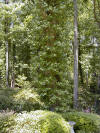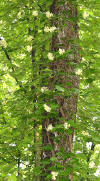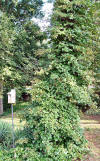|
Climbing Hydrangeas and Their Look Alikes When the garden is full, the only way to go is up. You can take advantage of that vertical space with carefree climbing vines that so beautifully fit the bill. There is a group of these vines that are so similar in appearance that it takes some examination to tell them apart. If you look closely in a not overly civilized part of your garden, you will probably find some specimens of our native Decumaria barbara. This semi-evergreen, woody-stemmed climber is frequently called climbing hydrangea. It is, in fact, in the family of Hydrangeaceae. The shiny ovate (pointed oval) leaves are two to four inches long. The vine climbs along the ground until it finds a tree to hang onto. It will grow happily as a groundcover, but will not flower until it attains some height. The aerial rootlets of Decumaria will help you identify it. While it will climb on its own, it may need some encouragement to climb the tree or structure that you choose. Once started, it climbs and begins to branch horizontally at regular intervals, giving the plant a very architectural presence in the garden, with or without leaves. The outstretched branches reach to two feet, with the main vine hugged closely to the tree trunk by aerial roots. In May, a mature vine will be covered with small, fragrant, flat-topped, white flower clusters at the ends of the extended branches. D. barbara prefers moist situations and acid soil. It will grow in the shade, but flowering improves in more light. Stem cuttings, taken in late summer or early fall, will take fairly easily, but once established it seeds itself in, providing small plants to be moved elsewhere or shared. A Chinese counterpart, D. sinensis, is available. A more elegant form of this native is the Hydrangea anomala ssp. petiolaris, the climbing hydrangea, which is now widely available at retail nurseries. It is also a deciduous, woody-stemmed climber, but the vine has exfoliating red bark as it ages, adding to the winter interest. The five-inch flower clusters contain not only the small white flowers of the native vine, but are surrounded by up to one and a half-inch sterile flowers which dress it in lace. It flowers best in bright light with adequate moisture, but will tolerate planting against a north wall. In Georgia’s climate, full sun is too strong for this vine. The shiny, dark green leaves of H. petiolaris are more oval than it’s cousin, and are finely toothed along the edges. The outstretched branches of H. petiolaris are slightly longer than Decumaria’s, at almost three feet. Both types have graceful downward curves in their side branches. The vine has the potential to grow to 50 feet in height, and to surround its base, like a skirt, in ground covering vines. It prefers well-drained, organically enriched soil and, once established, can tolerate some dry conditions. The vine can be allowed to climb a mature tree or a masonry wall, but should not be trained on a wooden wall as the aerial roots would cause damage. The seed heads dry well and contribute airy filler to the base of dried arrangements. Schizophragma hydrangeoides, Japanese hydrangea vine, is considered by some to be even more elegant than H. petiolaris. For many years, it was quite difficult to find. All the conditions required by the previous two vines mentioned apply to this vine as well, although it may appreciate slightly more shade. The broadly oval leaves are four to six inches and the flower heads are larger. The cultivar ‘Moonlight’ has silvery-green leaves that turn and shine in a breeze. You may propagate it by seed in spring and by greenwood or semi-ripe cuttings in summer. It can be expected to reach a height of 30 to 40 feet. A variety that offers larger, pink flowers, ‘Roseum’, has recently become available.According to Gene Griffith, of Wilkerson Mill Gardens in Palmetto,GA, S.hydrangeoides is “coarsely dentate and nearly glabrous”, or smooth leaved, with coarsely toothed leaf edges. Its cousin, Schizophragma integrifolium, has larger leaves, with hairy or pubescent reverse and less, to barely any, indentation in the margins. Schizophragma integrifolium the Chinese climbing hydrangea, has lacecap type flower heads surrounded by an outer whorl of distinctive white sepals, and is worth seeking out. The leaves reach 6 inches in length and the flower clusters can be as much as ten inches across. It is the shortest of the group, expected to reach a conservative 12 feet, which brings these beautiful blooms within sight. It is not as hardy as S. hydrangeoides, but should succeed as far north as Zone 7. The only true evergreen in this group is Pileostegia viburnoides (Syn. Schizophragma viburnoides). It grows in sun or shade, in well drained soil, but attains a height half that of most of it’s relatives, topping out at 20 feet. The tiny, creamy white flowers have many prominent stamens. The difficulty would be in finding a source of this vine. An internet search turns up sources in England, Italy and The Netherlands. A beautiful picture of the plant is available at www.esveld.nl/htmldia/p/pivibu.htm. An archival newsletter from the J.C. Raulston Arboretum at North Carolina State University, indicates that in 1992 there was a Pileostegia planted near the white garden. The vine had grown to 18 inches in eight years. Arboretum staff conjectured that the slow growth of the young plants made them uneconomical for trade. None of these vines requires pruning or has any pests or diseases of note. Moisture is their only requirement and you may get leaf drop from some with drought. So plant them where they can climb, water when necessary, and let them go. No matter which of these vines you choose and grow, they will raise your eyes from the garden floor and put on a show that can be appreciated from across the garden. |
click on thumbnails for larger images
Decumaria barbara hydrangea petiolaris Hydrangea petiolaris seedheads Hydrangea petiolaris hydrangea leaves Can you decide which is which from the text? LEFT
MIDDLE
RIGHT
You can see all the pictures above, plus a few more, with captions by clicking here.
|
|
Sources: |
|
Heronswood |
Schizophragma hydrangeoides 'Moonlight' Schizophragma hydrangeoides 'Roseum' Schizophragma
integrifolium var. fauriei DJHT 99125 plus 4 varieties of climbing Hydrangea |
|
Wayside Gardens |
Hydrangea anomala petiolaris 'Mirranda' variegated |
| Wilkerson Mill Gardens |
Decumaria barbara (Woodvamp) Schizophragma 'Roseum' |
|
Woodlander’s, Inc.
|
Decumaria barbara, Schizophragma integrifolia |





